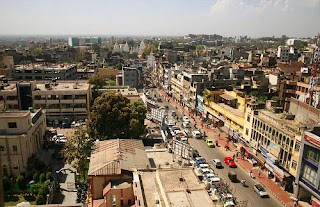Shri Babaji Maharaj and Shri Nathji stayed in Jammu for
some time. Shri Babaji Bhagwan chose to lead a life of great austerity and
physical hardship. Despite the invitation of the Maharaja of Jammu and Kashmir
to live with him, Shri Babaji Bhagwan preferred to live in a cave at Jammu
where multitudes thronged to him. Jammu, officially called Jammu-Tawi, is the largest city
in Jammu and Kashmir and the winter capital of the state. Jammu is also known
as "City of Temples" as it has many temples and shrines, with
glittering shikhars soaring into the sky, which dot the city’s skyline,
creating the ambiance of a holy and peaceful Hindu city.
Jammu was founded
by Raja Jambu Lochan in the 14th century BC. During one of his hunting
campaigns, he reached the Tawi River where he saw a goat and a lion drinking
water at the same place. Having satisfied their thirst, the animals went their
own ways. The Raja was amazed, abandoned the idea of hunting and returned to
his companions. Recounting what he had seen, he exclaimed that this place,
where a lion and a lamb could drink water side by side, was a place of peace
and tranquillity, thus he build his capital here.
There
are many interesting places to see in Jammu like
the Bahu Fort, which also serves as a religious temple, The Bagh-E-Bahu
located
on the banks of Tawi river, is a Mughal-age garden. It gives a nice view
of the
old city and Tawi river. Amongst the temples in Jammu, the Raghunath
Temple
takes pride of place being situated right in the heart of the city. This
temple
is situated at the city center and was built in 1857. This is a grand
temple. The
inner walls of the main temple are covered with gold sheet on three
sides. The adjoining,
Ragunath Bazar is the main tourist and shopping center of the city. It
has two
beautiful palaces, the Mubarak Mandi Palace and the Amar Mahal Palace,
which is
now a Museum. The photograph above is an Arial photo of modern day
Jammu. On top is the photo showing the city of Jammu on banks of the
Tawi river.




No comments:
Post a Comment